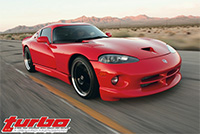 "Weaver began the project by shipping his Dodge to Underground Racing in Charlotte, NC. Underground Racing, a shop well versed in producing forced induction Vipers, tackled the task at hand by pulling the pushrod V-10 engine and disassembling it to its seams. A custom offset ground crankshaft was installed along with CP Pistons, billet main caps, Oliver connecting rods and Hellfire piston rings. Following all the internal work, the Viper's already monstrous displacement was increased from a huge 8.0L to an even more massive 8.4L."
"Weaver began the project by shipping his Dodge to Underground Racing in Charlotte, NC. Underground Racing, a shop well versed in producing forced induction Vipers, tackled the task at hand by pulling the pushrod V-10 engine and disassembling it to its seams. A custom offset ground crankshaft was installed along with CP Pistons, billet main caps, Oliver connecting rods and Hellfire piston rings. Following all the internal work, the Viper's already monstrous displacement was increased from a huge 8.0L to an even more massive 8.4L."
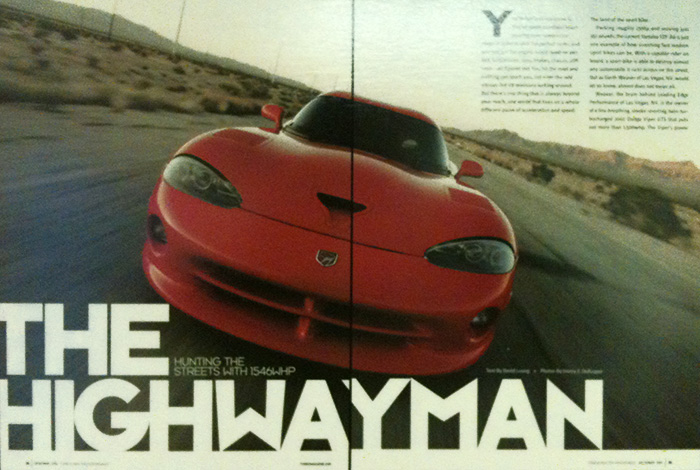 The Highwayman - 2002 Dodge Viper GTS
The Highwayman - 2002 Dodge Viper GTS
Hunting the Streets with 1546whp
(This story comes from the December 2006 issue of Turbo Magazine)
Story by: David Luong, Photos by: Henry Z. DeKuyper
You're fast and you know it. You've spent countless hours pouring over compressor maps in order to pick the perfect turbo, and you just got the engine tuned dead-on perfect. Suspension, tires, brakes, chassis stiffness - all figured out. You hit the road and nothing can touch you, not even the odd nitrous-fed V8 minivans lurking around. But there's one thing that is always beyond your reach, one world that lives on a whole different plane of acceleration and speed: The land of the sport bike.
Packing roughly 130hp and moving just 357 pounds, the current Yamaha YZF-R6 is just one example of how scorching fast modern sport bikes can be. With a capable rider on board, a sport bike is able to destroy almost any automobile it runs across on the street. But as Garth Weaver of Las Vegas, NV, would let us know, almost does not mean all.
Weaver, the brain behind Leading Edge Performance of Las Vegas, NV, is the owner of a fire-breathing, smoke-snorting, twin-turbocharged 2002 Dodge Viper GTS that puts out more than 1,500whp. The Viper's power output is enough to incite page after page of Internet web battling, but Weaver has little time to care about what other auto owners think of his ride. With 8.0 liters of displacement, two turbochargers and ten cylinders pounding away, there is almost no lag and boost is available anywhere in the rev range.
Weaver's best time so far is 9.1 seconds at 163mph in the quarter mile, and 8-second times are easily attainable with stickier tires. So Weaver's target of choice isn't a car, as there's been no four-wheeled vehicle that can catch this Viper. Rather, this Dodge was built to hunt down Las Vegas' most ballsy sport bike riders.
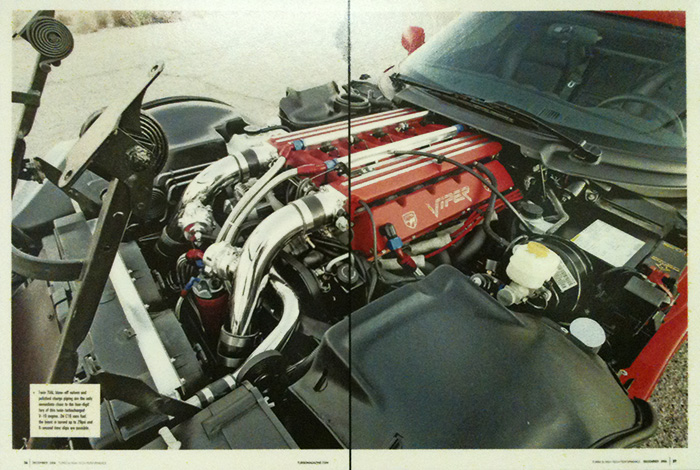
Few cars are capable of going this fast, and one would easily assume that any 1500whp ride is destined to end up wrapped around a tree. But Weaver is also the owner of a 1034whp street driven Toyota Supra that previously appeared in Turbo. Not afraid of four-digit power numbers, Weaver has been taking it to motorcycles for years on the Las Vegas pavement, and this American beast is his latest weapon.
Weaver began the project by shipping his Dodge to Underground Racing in Charlotte, NC. Underground Racing, a shop well versed in producing forced induction Vipers, tackled the task at hand by pulling the pushrod V-10 engine and disassembling it to its seams. A custom offset ground crankshaft was installed along with CP Pistons, billet main caps, Oliver connecting rods and Hellfire piston rings. Following all the internal work, the Viper's already monstrous displacement was increased from a huge 8.0L to an even more massive 8.4L. The camshaft was replaced with a custom "turbo" grind cam by Underground Racing, and Weaver had his cylinder heads ported and polished by Jeff Morey of Detroit, MI.
The turbocharger system uses twin Precision TE PT76 turbos, each hung on custom Underground Racing exhaust manifolds that are fed by opposing five-cylinder banks. A fitting was constructed to accommodate the TiAL external wastegate, routing exhaust gases into custom stainless-steel side exhausts and Burns Stainless four-inch mufflers.
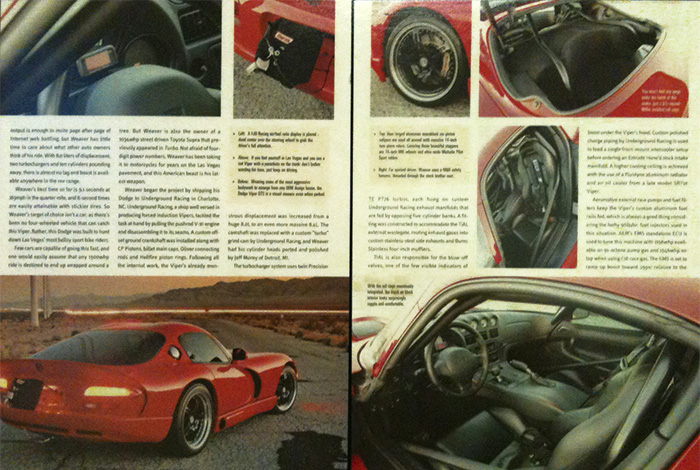
TiAL is also responsible for the blow-off valves, one of the few visible indicators of boost under the Viper's hood. Custom polished charge piping by Underground Racing is used to feed a single front-mount intercooler setup before entering an Extrude Hone'd stock intake manifold. A higher cooling ceiling is achieved with the use of a Fluidyne aluminum radiator and an oil cooler from a late model SRT10 Viper.
Aeromotive external race pumps and fuel filters keep the Viper's custom aluminum fuel rails fed, which is always a good thing considering the hefty 96lb/hr. fuel injectors used in this situation. AEM's EMS standalone ECU is used to tune this machine with 1156whp available on 91-octane pump gas and 1546whp on tap when using C16 race gas. The EMS is set to ramp up boost toward 29psi relative to the car's speed, although a Blitz boost controller is on tap for those rare situations when Weaver needs to dial in a single boost setting.
The Viper's stock six-speed transmission has stood up against four-digit power so far, although the stock clutch was changed out for a McLeod twin-disc unit. A Quaife limited-slip differential rests in the rear pumpkin, and Weaver went ahead and made the jump to Mark Williams CV-style halfshafts. He tells us that the Viper has proven itself to be both robust and reliable, even under the incredible strain that a twin-turbo V-10 and Weaver's heavy right foot regularly dish out.
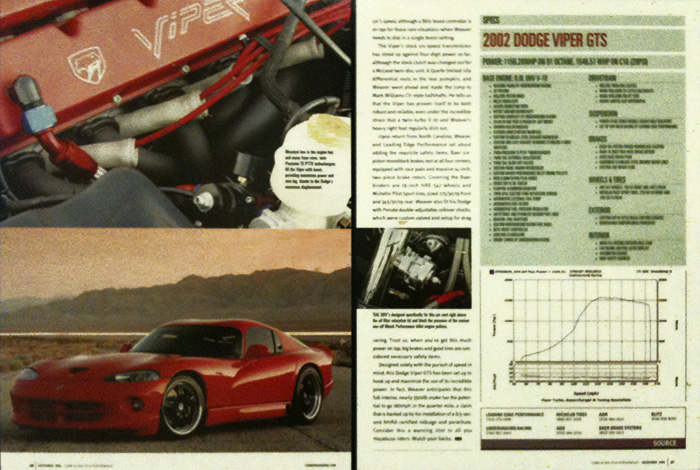
Upon return from North Carolina, Weaver and Leading Edge Performance set about adding the requisite safety items. Baer six-piston monoblock brakes rest at all four corners, equipped with race pads and massive 14-inch, two-piece brake rotors. Covering the Baer binders are 19-inch HRE 547 wheels and Michelin Pilot Sport tires, sized 275/30/19 front and 345/30/19 rear. Weaver also fit his Dodge with Penske double-adjustable coilover shocks, which were custom valved and setup for drag racing. Trust us, when you've got this much power on tap, big brakes and good tires are considered necessary safety items.
Designed solely with the pursuit of speed in mind, this Dodge Viper GTS has been set up to hook up and maximize the use of its incredible power. In fact, Weaver anticipates that this full-interior, nearly 3500lb snake has the potential to go 180mph in the quarter mile, a claim that is backed up by his installation of a 8.5-second NHRA certified rollcage and parachute. Consider this a warning shot to all you Hayabusa riders: Watch your backs.
Article Link: www.turbomagazine.com/features/0612turp_2002_dodge_viper_gts_twin_turbocharged/index.html
Additional Images: (click to enlarge)
http://212651.jnt1m.group/news/media-coverage/61-turbo-magazine-december-2006.html#sigFreeIdaddc61bc82
